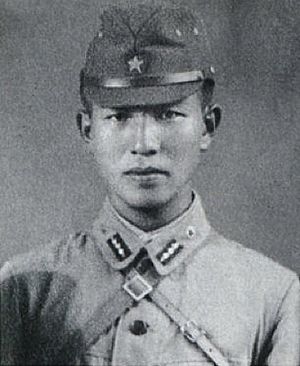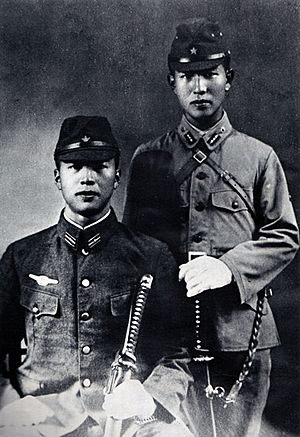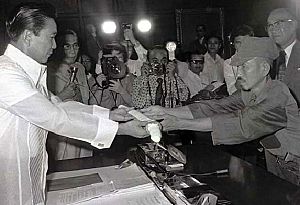Hiroo Onoda facts for kids
Quick facts for kids
Hiroo Onoda
|
|
|---|---|

Onoda, c. 1944
|
|
| Born | 19 March 1922 Kainan, Wakayama, Empire of Japan |
| Died | 16 January 2014 (aged 91) Tokyo, Japan |
| Allegiance | |
| Service/ |
|
| Years of service | 1942–1945 (continued voluntary service until 1974) |
| Rank | Second lieutenant |
| Battles/wars | World War II
|
| Other work | Cattle farmer Entrepreneur (Education) |
Hiroo Onoda (Japanese: 小野田 寛郎, Hepburn: Onoda Hiroo, 19 March 1922 – 16 January 2014) was a Japanese army officer who became famous for something incredible. He was a soldier in World War II and kept fighting for nearly 30 years after the war officially ended in August 1945!
Onoda was a "Japanese holdout." This means he was a soldier who continued to hide and fight because he didn't know the war was over. He stayed hidden in the Philippines until 1974. That's when his old commander had to travel all the way from Japan to tell him the war was truly finished. Onoda was a second lieutenant in the Japanese army. He was one of the last and most well-known Japanese soldiers to finally surrender.
Contents
Early Life and Joining the Army
Hiroo Onoda was born on March 19, 1922, in a village called Kainan in Japan. When he was 17, he started working for a trading company in China. A year later, at age 18, he joined the Japanese Army.
Military Training and Mission
Onoda received special training to become an intelligence officer, which is like a spy. He learned these skills at a secret school called the Nakano School.
On December 26, 1944, he was sent to Lubang Island in the Philippines. His orders were very clear:
- Stop enemy attacks on the island.
- Destroy the airstrip and the pier at the harbor.
- Most importantly, he was told never to surrender or take his own life.
When Onoda arrived on Lubang Island, he joined other Japanese soldiers already there. However, the other officers outranked him. They stopped him from carrying out his orders to destroy things. This made it easier for American and Philippine forces to take over the island when they landed in February 1945. Soon, most of the Japanese soldiers on the island were either killed or surrendered. Only Onoda and three other soldiers remained. Onoda, who had been promoted to lieutenant, told his men to hide in the mountains.
Living in Hiding for Decades
Onoda and his three fellow soldiers—Yuichi Akatsu, Shōichi Shimada, and Kinshichi Kozuka—lived in the mountains of Lubang Island. They continued to act like guerrilla fighters, meaning they used surprise attacks and hid. They also had several shootouts with local police.
Why They Didn't Surrender
In October 1945, they found a leaflet that said Japan had surrendered. It read: "The war ended on 15 August. Come down from the mountains!" But Onoda and his men didn't believe it. They thought it was a trick by the enemy. They also figured if the war was over, no one would still be shooting at them.
Later in 1945, planes dropped more leaflets with a surrender order from a Japanese general. The soldiers studied it carefully but decided it wasn't real. They thought it was another trick.
The Group Shrinks
- In September 1949, Yuichi Akatsu left the group. He surrendered to Philippine forces in March 1950. This made the remaining soldiers even more careful.
- In 1952, letters and family pictures were dropped from planes, asking them to surrender. But the three soldiers still believed it was a trick.
- In June 1953, Shōichi Shimada was shot in the leg during a fight with local fishermen. Onoda helped him recover.
- On May 7, 1954, Shimada was killed by a search party looking for the men.
- On October 19, 1972, Kinshichi Kozuka was killed by local police. He and Onoda were burning rice collected by farmers as part of their guerrilla actions.
Now, Onoda was completely alone.
How Onoda Was Found
On February 20, 1974, Onoda met a young Japanese man named Norio Suzuki. Suzuki was traveling the world looking for "Lieutenant Onoda, a panda, and the Abominable Snowman." Suzuki found Onoda after searching for four days. Onoda later said that Suzuki was a "hippie boy" who wanted to hear a Japanese soldier's story.
Onoda and Suzuki became friends. But Onoda still refused to surrender. He said he was waiting for orders from a higher-ranking officer. Suzuki returned to Japan with photos of Onoda as proof. The Japanese government then found Onoda's former commanding officer, Major Yoshimi Taniguchi, who had become a bookseller.
Taniguchi traveled to Lubang Island. On March 9, 1974, he finally met Onoda. Taniguchi kept a promise he had made in 1944: "Whatever happens, we'll come back for you." He then gave Onoda the official orders to stop fighting.
Onoda was properly relieved of his duty and finally surrendered. He was the second-to-last Japanese soldier to be found after the war. The very last was Private Teruo Nakamura, found in Indonesia in December 1974.
Life After Surrender
When Onoda returned to Japan, he became very famous. Some people even wanted him to run for Japan's parliament. He quickly wrote a book called No Surrender: My Thirty-Year War, which told his story.
The Japanese government offered him a lot of money as back pay, but he refused it. When well-wishers gave him money, he donated it to a shrine.
Onoda found it hard to adjust to modern Japan. He felt that traditional Japanese values were disappearing. In April 1975, he moved to Brazil and started raising cattle. He got married in 1976 and became a leader in a Japanese community in Brazil. He even let the Brazilian Air Force train on his land.
In 1984, Onoda returned to Japan after reading about a Japanese teenager who had murdered his parents. He then started the "Onoda Nature School" for young people. These camps taught survival skills and traditional values.
The President of the Philippines, Ferdinand Marcos, officially pardoned Onoda for his actions during his time in hiding. In 1996, Onoda visited Lubang Island again. His wife arranged a US$10,000 scholarship donation for the local school there.
Onoda spent about three months each year in Brazil. He received awards from the Brazilian Air Force and was made an honorary citizen of a Brazilian state.
Death
Hiroo Onoda died on January 16, 2014, in Tokyo, Japan, from heart failure caused by pneumonia. He was 91 years old. Japan's Chief Cabinet Secretary, Yoshihide Suga, praised Onoda's strong will to survive.
See also
- List of Japanese holdouts
- Shoichi Yokoi, another Japanese holdout found in Guam in 1972
- Survival skills
- Teruo Nakamura, the last known Japanese holdout to surrender
 In Spanish: Hirō Onoda para niños
In Spanish: Hirō Onoda para niños



